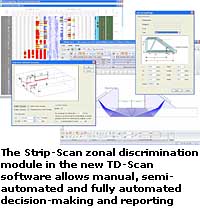AGR Field Operations releases new TD-Scan software
07/10/2010
 AGR Field Operations has announced the latest version of the TD-Scan advanced ultrasonic software.
AGR Field Operations has announced the latest version of the TD-Scan advanced ultrasonic software. Version 18.01 was released at the beginning of September 2010 and is bursting with new features which strengthen the existing well-known package. The software has always been a favourite among many because of its understandable user interface and easy workflow. Over almost 15 years since the TD-Scan software was conceived and written by Ian Baker, it has evolved from a humble pulse-echo and TOFD application to the sophisticated multi-functional package on offer today, that has the addition of phased array, zonal discrimination, advanced imaging and analysis tools, controls for automated and semi-automated scanners and many specialist applications encompassed in the shell.
The software has been changed to accept multi-lingual translations and can currently be displayed in English, German, French and Chinese. Other languages may be added simply and effectively by using a translation facility provided by AGR’s software department.
Owing to the ever-increasing demand and code requirement, one of the biggest recent developments in the industrial ultrasonics world has been computer-based ray-tracing software. When using multiple beams, visualisation of test-piece geometry and sound beam interaction with the internal topography is vital in determining the placement of probes and indeed may influence the choice of probe and wedge. In collaboration with Eclipse Scientific Inc, importing phased array and TOFD scan plans from ESBeamTool3 is now a standard feature in the software. All probe, wedge, offset, focal law and test-piece geometry may be imported from ESBeamTool via a simple data exchange procedure. The existing test-piece geometry overlay tools included in the TD-Scan software have also been improved and it is now possible to define standard weld geometry as well as complex piece geometry from within the software. The ability to overlay these images on live and offline data dramatically improves the engineers’ ability to visualise beam interactions.
In order to make the selection of phased array probe and wedge data easy for the user, tools to enter new wedges and probes and edit existing parameters in the existing database have been added to the interface. This allows for easy selection of probe/wedge combinations and the inclusion of special configurations.
The Strip-Scan zonal discrimination module has been improved to allow manual, semi-automated and fully automated decision making and reporting. By adding controls to define multiple amplitude thresholds and assign colours to each threshold, manual evaluation is possible at a glance, simplifying the process and reducing the possibility of human error. Additionally, complex proximity rules may also be defined in the software which, combined with the threshold acceptance data, allows automatic data evaluation according to virtually any code requirement. The results may be displayed on strip charts and detailed defect information is recorded which may be automatically output to a user-definable report format.
There are many other improvements within the software, most notably the addition of controls that allow the user to define certain processing and imaging processes that improve scanning speeds by up to 150% of that which was previously achievable for phased array data collection.
Although the TD-Scan software is evolving into a highly complex package, the authors have achieved a balance between complexity and usability. One of the greatest strengths of the software is its integrated construction and efficiency across the range of AGR’s TD brand hardware products.
www.agr.com